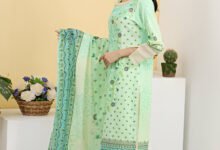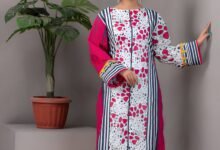Top Stylish Salwar for Men: Traditional Meets Modern Fashion

The Change In Fats Men’s Fashion
Traditionally the Indian sub-continent has been synonymous with rich cultural history and diverse styles of fashion. A couple of decades ago, women had already taken over the fashion Industry with sarees, lehengas and salwar kameez becoming a global sensation whereas men’s fashion has also come through an interesting transformation only to look for better than ever before.
How to Wear Chikan Kurti with Jeans Like a Pro
Of all the traditional clothing wear, salwar for men is an indigenous style search that originally women stopped to try and fashion evolved into a modern man. Keywords: salwar for men, gendered garment and fluid style trends in modern india
Background on Men Salwar
The salwar used to be the standard clothing option for men in several parts of India, particularly in the north. The salwar is also a product of the Punjab, usually paired with kameez. But it goes as far back to Mughal period, where this unassuming attire became popular with both men and women for its practicality. The Mughals, known for their love of silks and heavy embroidery, made it a symbol of the royal attire.

In subsequent years, as British colonialists had greater control over Indian fashion it drastically cut off the dressing styles of men wearing a Safa or Salwar [8] Meanwhile WHen Western attire like trousers and suits were introduced to India. Yet, the salwar never went out of men’s wear in rural regions and certain communities especially in Punjab where it shared its popularity with jodhpur pants called chadidar pagadi, Haryana and some parts of Rajasthan.
Salwar Trend Campaign among Men in Modern Fashion
Traditional wear for men has seen a huge leap in popularity over the last few year domestically, and within Indian fashion globally. This revival is more of a throwback to the roots but also contemporizing ethnic wear. The men’s salwar is leading the pack here representing comfort, fashion and cultural pride.
These days, designers across the country are experimenting with salwars to give refreshing twists by changing and voicing for innovative options in cut, fabric as well cuts which moves parallel to modern way of living. Salwar is loose-fitting, easy to wear and the endless possibilities of combining it with different upper garments like kurtas, sherwanis or even modern shirts too makes salwars an indispensable part of your wardrobe.

One of the primary reasons why search for salwar men has been skyrocketing up in India is simply because it makes versatile — that otherwise not many other menswear variant do.
Men’s Salwars : The Types And Style
However, the Salwar though looks simple it has been designed in numerous styles to enable you have choice of selection for different occasions or based on your preference. Here’s a detailed look at four of the most common types:

1. Classic Salwar
The classic salwar: It is marked by its bagginess and that slight taper from the top till the ankle. These pieces are generally made of cotton or silk hence very comfortable and wearable for all day. It is generally worn along with a kurta or kameez forming an elegant traditional wear. On the one hand, the classic salwar worn with a kurta is most widespread in northern India — specifically Punjab and Haryana (where it has truly become sartorial gold for men).
2. Churidar Salwar
Churidar Salwar- This type of salwar is fitted ones. It fits tight till the calves and ankle; this gives a bunched or wrinkled effect known as “churi” (bangles). This is especially famous and mostly opted for in formal occasion when paired with sherwani or long kurta. Since the churidar salwar comes with a look that contours so perfectly, it is an obvious choice for men who like their clothes to sit tight but want something between western wear and traditional attire.
3. Pathani Salwar
Just like for women we have the salwar now that comes straight from our Pathan community -the menswear variant which is called a Pathani Salawar. It is more relaxed than churidar and pairs with a long kurta called the Patani suit. The Pathani salwar is commonly worn in dark, muted colors and liked for its tough macho charm. This is a common attire at festivals, weddings and other cultural events.
4. Aligarh Salwar
Aligarh salwar is a slimmer version of traditional Salwaar and occasionally called Aligarh pyjama. The city of Aligarh and its nearby regions are mad over it. Slashing SalwarAligarh salwars provide a slender look, for simple as well fit men to start with the bubble between them and the contribution of patients(CancellationToken)benefits. This style is usually complemented with short kurta or achkans, making it a top for wedding and other formal occasions.
5. Afghani Salwar
Afghani salwar — A loosely fitted, comfortable wear commonly worn in regions with a large Afghan population such as North India. It is generally worn with a short kurta or an A-line tunic and comes in relaxed baggy fit. The Afghani salwar is casual wear suited for the hot and humid climate, since it is made of lighter fabrics like cotton or linen.

Modern Versions and Involvement from Fashion Designers
Today this loose pants for men has resurged in interest… If I may say, due to the influence of some contemporary Indian designers. The salwar has been reinvented with a contemporary twist by designers including Sabyasach Mukherjee, Manish Malhotra and Rohit Bal without losing its traditional look. It has been these designers that contributed heavily in bringing the salwar to men formal and casual wear again.
1. Experimentation with Fabrics
Salwars for Men is now not limited to just cotton and silk textiles anymore, it has evolved in a modern way also. Fashion designers are draping in cotton, velvet or even denim and an excess of others. They not only bring a breath of fresh air in the way salwar are looked at, but can also be sported throughout different seasons and events. A velvet salwar with brocade sherwani is perfect for a grand wedding ensemble and these leafy kurties are just right to wear at your very next summer festivals!
2. Win-Win Merging of Tradition and Contemporary Styles
The salwar is emerging to be a trend with another most recent of its kind being the fusion between Western and traditional modes. Modern clothes made using chemically treated stuff is harmful to the ecosystem and our health too but fusion wear of MP Govt Saree Salwar(मध्यप्रादेश सरी-सलुंक) now designers are pairing with Western dresses like jackets, blazers, or t-shirts. Apart from this fusion to cater nowadays generation, it also helps make traditional attire more evident and relevant in a knitted world.
3. Embroidery and Embellishments Incorporation
Embroidery and embelishments are another classic features of our renowned Indian fashion,so in the category of salwar for men it is also part. The salwar is now elevated and designers are using it decoratively with the use of intricate embroidery, zardozi work, etc., making a simple garment an over-the-top statement. These ornate salwars are highly in demand for weddings etc due to their luxurious ornamentation and add an imperial touch to the ensemble.

Society Acceptance And Papule Importance
The increasing fascination in “salwar for men” is also a part of a larger cultural change happening in India. Traditional garments are making a way for themselves in mainstream fashion, with more men readily embracing the trend of experimenting in their closet. Much of it is being propelled by a wave of cultural revival and people longing to touch base with their roots. Putting on clothes like the salwar is more than simply a style statement; it’s fashion plus custom.
Apart from this, it is very much a gender rebellious act in the world of fashion when men adopt salwar as a part masculine wear. When it comes to a society where clothing has frequently been marked by its gender, the sudden falsifying of salwars in men’s fashion speaks volumes for which we are heading towards and this may be termed as an inclusive perspective or fluid outlook on style. This change is particularly impactful in urban locations where younger generation resist breaking from traditional fashion.
Bollywood and Popular Media
Being the most followed culture in our country, Bollywood played a vital role to make salwar for men into a trend. The salwar is no exception to the role of Indian cinema and actors as a fashion influence in India. Traditional attire such as salwars for men in India can be seen through a number of films that portray historical or cultural themes like Jodhaa Akbar and Bajirao Mastani, which has greatly influenced mainstream fashion.
Additionally, the salwar has a rich legacy as it is often promoted by celebrities and fashion influencers when they sport traditional wear in events like festivals or weddings which are both considered to be men-friendly clothing choices. The change in perception towards salwar might also have been facilitated by the presence of salwars on popular media, which definitely would account for a large proportion of search interests and gradual acceptance among Indian men.
You can easily sport men’s salwar for functionality and comfort
Not only this, but the salwar is also loved for its practicality and comfort. This loose fit of the salwar makes it ideal for life in diverse India, from the heat stroke inducing plains to pleasant cool weather that envelopes many a hill. The salwar, on the other hand is loose and airy (besides being extremely comfortable), making it a preferred choice for rural wear as well as by our seniors.

Swapna is another consistent difference which may be one of the reasons why this salwar remains so popular. Perfect for any occasions, by just dressing it up or down. Must-have item in every wardrobe hor! As in a basic cotton salwar for casual everyday wear and silk or brocade worn with sherwani (wedding/festive).
Influence and Regional Differences
Different regions of India present their own distinct versions of salwar for men which gives a nod to the rich culture that this land is filled with. Depending on the areas and initiated times of constructing this historical apparel, their changes in shape outlook would differ from regions.
1. Punjab and Haryana
Literally a pair of words combining the salwar (loose pajama-like trousers, wide at the hips and narrow ankle) with kurta kameez, literally it means loose knee-long shirt. A loose, airy fit defines the traditional Punjabi salwar and is worn for Baisakhi celebrations or weddings. The bright hues and decorative embroidery characteristic of Punjabi clothing can also be seen in the salwar, which is a very colorful piece.
2. Rajasthan
In the state of Rajasthan, also in northwestern India, it is worn with a long (usually knee-length) tunic-top or short dress. The Rajasthani dhotar is a salwar of sorts, but it’s traditionally made in vibrant silk or other fabric with equally ornate embroidery/ mirror work. This particular style is a representation of the liveliness in Rajasthan and has always been spotted during festivals,made use traditionally too.
3. Kashmir
Kashmir: The traditional salwar in Kashmir is paired with a long kurta which has slits on both sides and it is teamed up all together to wear as “pheran. Kashmiri salwar: Worn in the Sindhi-Balochistani regions of Pakistan alongside loose shirts that reach slightly above or below knee-length. It is winter wear, being made from wool or other warm fabrics appropriate to a cold-weather region. Kashida is very popular and is appreciated work of kashmiri ladies fashion which you can see mostly on the salwar to give an affluent appearance.
4. South India
Although salwar is typically worn in North India, it has made a place for itself even in southern regions like Tamil Nadu especially at weddings or another form of serious occasion. South India: South Indian women often wore the salwar with a silk kurta, not to forget that in Sherwani flow for southern region language of rich luxury and dense color. The South Indian style salwar is usually a bit more fitted than the North and may include details of churidar.
Future of salwar for men in Indian fashion
The trend of the salwar for men in India is not a fad; it represents fashion and cultural values. Even as India evolves towards modernity and globalization, an equally strong throwback to its roots is visible with the trend of going back to traditional. The salwar carries a lot of history and culture with itself which altogether are likely to ensure its permanence as one of the regulars in menswear across nations for years.
Also, the rise of searches around “salwar for men” shows that more men are finding their way back to traditional dressing looking at it from a comfort and style perspective as well as cultural identity. We can expect this trend to stay around as designers, celebrities and style influencers all continue promoting the salwar by Men … versatile+dapper!
Summing it up we can say that the salwar for men is an interesting grain in Indian fashion — where traditional meets modern. A wholecloth dress is naturally comfortable and efficient, as well as a symbolic representation of the culture. As the fashion landscape in India changes, it appears that the salwar could well become a prominent item on every man shelf which will weirdly also define its uniqueness. Whether you wear salwar for men during wedding time, festival or everyday attire this garment will prove that Indian traditional fashion never fades away.



